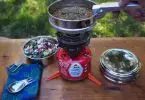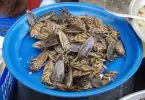Here you are – you’ve scouted out the trail you want to hike on, you’ve got your gear out of the closet, and now you’re ready to get the last-minute things together. Are you wondering about the perfect food to bring backpacking? This backpacking food tips guide can help you decide the best, most efficient and wallet-friendly options for your upcoming backpacking trip, whether it’s a one day in and back, a single overnight, or multi-day trip.
As you’re preparing, the considerations you should keep in mind are the following: cost, ease of preparation, space, nutrition level, and overall quantity needed. You’re going to make sure you have all your meals covered, to start with.
Running out of food in backcountry would not be a good thing! Plan out ahead of time how many meals you’re going to have, and that each one will deliver enough protein, fat, and carbohydrates to keep your energy levels high while hiking. Do check out our piece on how to prepare dehydrated food to bring to camp for more options.
If you’re going on a day hike or overnight hike, this will obviously be a little bit easier than if you’ll be out for several days. If you’re doing a multi-day hike or a through-hike, you’ll also want to loosely plan when you’ll come across a trail station, or get close enough to a town to restock your food supply.
Don’t sleep on the snacks!
Once you have a loose idea of what you’ll need and when you’ll need it, you can start planning out each meal, depending on your tastes. Don’t forget to think about snacks! Especially if you’re trying to do a certain amount of mileage before sundown, or you need to reach your campsite before then, you won’t want to stop and languidly cook a meal. Snacks that are easily accessible and protein-packed will help keep your energy up until you get to your final destination of the day.
Now, there are some who get really tired really quickly of eating granola bars for snacks or as part of a meal while they’re on the trail – I’m not one of those people, though, and I think once you find a brand that really tastes good to you, you’ll be happy to have these accompany you.
My favorite brands are both KIND and PRO BAR, because they have such a wide variety of flavors, are vegetarian, use a variety of nuts and don’t have a ton of added sugar. If you’re not one of these people, however, you can pack things like whole-wheat crackers and a hard cheese (keeps better than soft cheese), beef jerky, apples and any kind of nut butter (almond and peanut are good ones for high fat and protein) for when you need a boost.
Meals and materials
When it comes to planning out the actual meals, this is where you’ll need to be a little more intentional with your purchases. If you’re spending even one night out on the trail, let alone 30, you’ll most likely want to look forward to a hot meal at the end of the day. Even if it’s just noodles or instant potatoes, there’s something comforting about a warm dinner. See our review of the top backpacking food to ensure you have gourmet-like meals on the go.
It also means, though, that you’ll need to research fire policies for the campsite you’re staying at, figure out if you want to bring a portable gas cooking stove (multi-day hikers most often opt for this), or jerry rig one up once you get there. Additionally, think about leave-no-trace camping, and make sure you have bags to pack trash out, and ways to tie up your trash away from your tent(s).
Some other things to think about
Firestarters
These can be anything from matches, to lighters, to DIY kindling balls made of dryer lint, to newspaper logs. Think about what you’ll want to carry on your back, as well as what you’re willing to deal with at the end of a long day’s hike.
Water
Will you need to boil water to cook whatever it is you’re eating? Instant meals are great, but you will need to consider if you’ll have access to water where you’re camping, if you’ll be able to refill along the way (and thus might need a filter), or if you’re doing a shorter hike, if you can bring what you need with you.
Ideally, you’d plan how many cups you need to prepare the meal in this case, plus enough to stay hydrated, and bring just enough (water is heavy), plus an extra cup or two. Consider what you’ll need to make that great cuppa in the morning, as well!
Repackaging
If you’ve grown up in the US, or spent any time there, you’ll know that the amount of extra packaging on things can border on ridiculous. Other times, you’ll want to bring things along that are just too fragile in their current state, and so repackaging will allow you to bring things in bulk without worrying about breaking them into an inedible mess.
The greatest examples here are crackers, eggs, and pancake mix. Nothing is worse than looking forward to a great snack of cheese and crackers, and finding salty dust in the cracker package, or reaching into your pack and feeling the gooey wetness of a broken egg.
It is suggested to hang crackers from the outside of your pack, or packed tightly together in a hard-shell tupperware if you need to store them inside. Eggs can be pre-scrambled and stored in a plastic or glass container (bonus points if it’s one with an easy pour spout, like an old CoffeeMate jug!); pre-made pancake mix can be stored the same way, or in a big ziploc bag. Yum!
Now for the fun part…
Now that you’ve got these things in mind, it’s time to decide what food to bring. Here, we’ll divide this up into three sections: day hikes, overnight hikes, and multi-day hikes. The latter two sections will have some overlap, since folks in these camps (no pun intended) will be more likely to want to cook over a fire or stove, and will need to think ahead a bit more about saving space and weight.
Day Hikers
This list is compiled assuming you’ll head out after you’ve had a hearty breakfast (early morning departure or later, breakfast is the most important meal of the day, just like mom said). Ideally, your breakfast will give you enough fuel to get through the first few hours of the hike, until you decide it’s lunchtime. Think about including complex carbohydrates, protein, fat (the good kind), and caffeine (if that’s your bag).
A classic breakfast could be: peanut butter on toast, scrambled eggs with avocado, and a banana. Another could be oatmeal with sliced banana and almonds, with yogurt and fruit on the side. Coffee and water would accompany each of these.
You’ll most likely want to bring nothing more than a backpack (day pack). Before you think about anything else, your first thought should be water. At minimum, one liter is how much you should plan to bring. If it’s hot and you’ll be sweating, two liters might be more accurate. If you decide to bring two, it is suggested to bring one with you, and leave one in the car in a thermos that keeps things cold for when you get back from your hike. So refreshing!
Next, you’ll have to think about lunch and snacks. The most efficient lunch would be a sandwich – you can pile all the energy-packed goodies onto a bagel or roll, wrap it in tinfoil, and be set. Bagels are great alternatives to bread or rolls because they’re denser, and thus have more carbohydrates. Plus, they’re delicious.
If you add any kind of nut butter (almond, sunflower or peanut being among the best choices) to it, you’ll be set for your carbs and protein for the rest of your hike. Otherwise, pile it high with veggies and maybe some cheese, and maybe some meat too.
If you’re not a sandwich person, no worries! Bring assorted fruits (bananas, raisins and apples are the easiest in terms of preparation and packing out), mixed nuts (think almonds, cashews, and walnuts), and power bars will serve you just as well. And if you’re going with friends, they’re easier to share!
Overnight Hikers
Again, this list assumes you’ve already had a good, hearty breakfast. Next, consider the amount of water you’ll need to bring with you to last for the next 24+ hours. Remember to calculate in water for drinking, water cooking, and water for rinsing out any cooking pots, pans, utensils, etc.
Then, go meal by meal. Since you’ll only be away from the comforts of a home-cooked meal for a night, you can probably get by on an instant or near-instant meal and be just fine. Top recommendations would be:
Lunch, day 1: Sandwich! Regular sandwich on a roll, a bagel-wich, or if you’re feeling like you want to be ultra-light, tortilla sandwiches are just as good! Tortillas are multi-functional as both sandwich bread and snacks for later; you can buy individual packs of peanut butter or almond butter, or repackage some hummus into a ziploc for dipping into later. Both nut butters and hummus serve as a great protein boost.
Snack, day 1: This may or may not be necessary. If you’re hiking with family, and that includes small children, this is a non-negotiable, and so some trail mix (think basic peanuts, cashews, raisins, M&Ms, maybe hunks of granola) comes in quite handy here. Lunch meats like salami, plus cheese and crackers can be a great addition. You can also fall back on your kids’ favorite energy bars, the classic “ants on a log” (peanut butter and celery and raisins) which are easily assembled, or jerky.
Some hikers choose to opt out of a full lunch, since they don’t want to lose inertia (or are afraid it will be hard to motivate their kids to get back hiking after stopping), and so choose to eat several smaller things throughout the day. All these snacks can be packed in tupperware or ziploc bags, and are lifesavers for those in this situation!
Dinner, day 1: Bring on the dehydrated noodles, canned tuna, and instant potatoes! No, in all seriousness, these are your best options, especially if you’re out on the trail as a family. Low-intensity prep, high-reward, and small clean up (just remember to pack everything out). Regular pasta, rice, or cous-cous also work really well for dinner, and you can bring your own spices/seasonings, which altogether wouldn’t take up that much more room than pre-packaged meals.
Breakfast, day 2: Coffee. Or tea, at least. Tea is intuitively easier – throw a sachet or two into a cup of boiling water – and voila! However, there are ways to make your own coffee sachets with real coffee and a filter, or you can bring the instant stuff. Again, you’re only away from the comfort of your coffee maker for one morning – if you’re not a fan of instant coffee, we can all agree that at least something is better than nothing.
To eat, think again of easy prep, easy clean-up things that pack in the energy: oatmeal, scrambled eggs, protein bars, trail mix. Depending on when you’re planning to leave the trail, you can use this as an opportunity to eat the rest of your food so you don’t have to carry it (or at least significantly reduce your stock).
For snacks and lunch on day 2, again think about using the rest of what you had for lunch dinner the day before. Tortillas and hummus, peanut or almond butter, jerky, trail mix, another apple, crackers with cheese and salami – these should all tide you over until your hike is done.
Multiday Hikers
For those of you who will be away from home for several nights, you might actually have it the easiest in terms of the amount of decisions to make. Yes, you’ll need a cooking stove and gas, and yes, you’ll need to be more intentional about rationing water.
However, you can pack a bunch of bags of trail mix, maybe changing up the variety among them, add in some instant potatoes, canned beans, tuna, and soup, grab some tortillas, and dehydrated meals and you’ll be set. Thru-hikers and ultra-light backpackers may want to skip the canned items, as they do add quite a bit of weight – in this case, dehydrated meals are your friends.
Breakfast depends on your tastes – for some, coffee is a non-negotiable thing to have, especially as you get further into your hike and the muscle exhaustion starts to set in. Oatmeal is a common breakfast food too, although some swear by bringing pre-made pancake mix (though with raw eggs, be careful and make sure to eat it fairly soon after making it), just to have some comfort.
See also: Vegan Backpacking Food: Tasty Nutritious Food Choices for Outdoor Lovers
There’s also dried cereals, or protein bars without a lot of added sugar. Things like fresh produce will have to wait until you stop at a trail shelter, or head into a town to resupply.
Heading out
Well, here we are: it’s time to hit the trail! You’ve checked all the trail and campsite rules, and estimated how much water you’ll need.
You have extra bags for packing out trash, you bought a can opener, a little gas camping stove (and the gas), repackaged your hummus, eggs, and pancake mix, planned how many miles until you can restock your food bounty, and stuffed into your pack as many energy bars and homemade coffee sachets as possible. Now all that’s left is the hearty breakfast before you head out! See our useful tips on how to make your own backpacking food to save on cost – it’s so easy!
Featured Image Source: https://unsplash.com/photos/jMbpZh6QrK4







